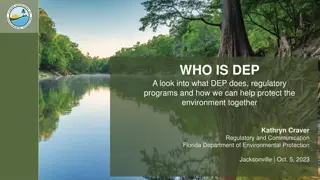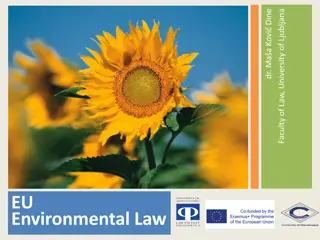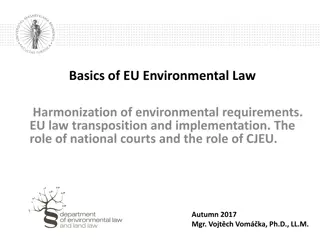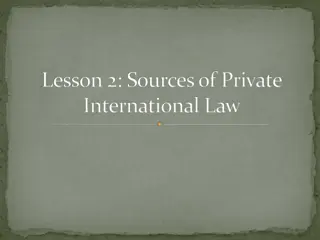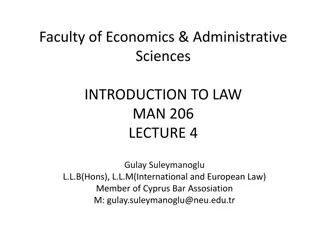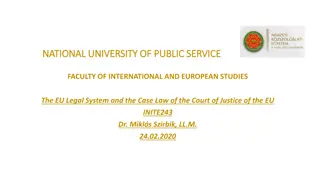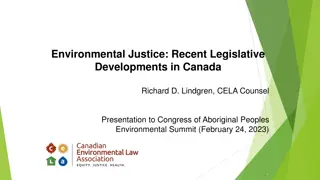Understanding Environmental Law and Its Principles
Environmental law encompasses regulations that protect the environment and natural resources. It has evolved to address global concerns through principles like sustainable development, equity, and transboundary responsibility. These principles guide the development and implementation of laws to ensure the well-being of current and future generations.
Download Presentation

Please find below an Image/Link to download the presentation.
The content on the website is provided AS IS for your information and personal use only. It may not be sold, licensed, or shared on other websites without obtaining consent from the author. Download presentation by click this link. If you encounter any issues during the download, it is possible that the publisher has removed the file from their server.
E N D
Presentation Transcript
Environmental law is a collective term encompassing aspects of the law that provide protection to the environment.A related but distinct set of regulatory regimes, now strongly influenced by environmental legal principles, focus on the management of specific natural resources, such as forests, minerals, or fisheries. The concept of "environmental law" as a separate and distinct body of law is a twentieth-century development.The recognition that the natural environment was fragile and in need of special legal protections, the translation of that recognition into legal structures, the development of those structures into a larger body of "environmental law," and the strong influence of environmental law on natural resource laws, did not occur until about the 1960s. By the end of the twentieth century environmental law had been established as a component of the legal landscape in all developed nations of the world, many developing ones, and the larger project of international law.
Principles: Environmental law has developed in response to emerging awareness of and concern over issues impacting the entire world. Discussed below are important principles for the understanding of environmental law around the world. 1. Sustainable development Defined by the United Nations Environment Programme as "development that meets the needs of the present without compromising the ability of future generations to meet their own needs," sustainable development. The modern concept of sustainable development was a topic of discussion at the 1972 United Nations Conference on the Human Environment (Stockholm Conference), and the driving force behind the 1983 World Commission on Environment and Development (WCED, or Bruntland Commission). In 1992, the first UN Earth Summit resulted in the Rio Declaration, Principle 3 of which reads: "The right to development must be fulfilled so as to equitably meet developmental and environmental needs of present and future generations." Sustainable development has been a core concept of international environmental discussion ever since, including at the World Summit on Sustainable Development (Earth Summit 2002), and the United Nations Conference on Sustainable Development (Earth Summit 2012)
2. Equity Defined by UNEP to include intergenerational equity - "the right of future generations to enjoy a fair level of the common patrimony" - and intragenerational equity - "the right of all people within the current generation to fair access to the current generation's entitlement to the Earth's natural resources" - environmental equity considers the present generation under an obligation to account for long-term impacts of activities, and to act to sustain the global environment and resource base for future generations. Pollution control and resource management laws may be assessed against this principle. 3. Transboundary responsibility Defined in the international law context as an obligation to protect one's own environment, and to prevent damage to neighboring environments, UNEP considers transboundary responsibility at the international level as a potential limitation on the rights of the sovereign state.[Laws that act to limit externalities imposed upon human health and the environment may be assessed against this principle.
4. Public participation and transparency Identified as essential conditions for "accountable governments,... industrial concerns," and organizations generally, public participation and transparency are presented by UNEP as requiring "effective protection of the human right to hold and express opinions and to seek, receive and impart ideas,... a right of access to appropriate, comprehensible and timely information held by governments and industrial concerns on economic and social policies regarding the sustainable use of natural resources and the protection of the environment, without imposing undue financial burdens upon the applicants and with adequate protection of privacy and business confidentiality," and "effective judicial and administrative proceedings." These principles are present in environmental impact assessment, laws requiring publication and access to relevant environmental data, and administrative procedure. 5. Precautionary principle In order to protect the environment, the precautionary approach shall be widely applied by States according to their capabilities. Where there are threats of serious or irreversible damage, lack of full scientific certainty shall not be used as a reason for postponing cost-effective measures to prevent environmental degradation.
6. Prevention The concept of prevention . . . can perhaps better be considered an overarching aim that gives rise to a multitude of legal mechanisms, including prior assessment of environmental harm, licensing or authorization that set out the conditions for operation and the consequences for violation of the conditions, as well as the adoption of strategies and policies. Emission limits and other product or process standards, the use of best available techniques and similar techniques can all be seen as applications of the concept of prevention. 7. Polluter pays principle The polluter pays principle stands for the idea that "the environmental costs of economic activities, including the cost of preventing potential harm, should be internalized rather than imposed upon society at large."[14]All issues related to responsibility for cost for environmental remediation and compliance with pollution control regulations involve this principle.
International biodiversity law : In the past two decades, international environmental law has become increasingly driven by the concept of sustainable development, which now underpins to a great extent the global environmental debate. This is also the case in biodiversity conservation; principles and concepts related to sustainable development permeate the provisions of the more recent instruments and are, to some extent, being adopted at a national level. The following conventions and instruments are of prime importance to biodiversity conservation: Convention on Wetlands of International Importance, Especially as Waterfowl Habitat 1971 Convention on International Trade in Endangered Species 1973 Convention on the Conservation of Migratory Species of Wild Animals 1979 Convention on the Conservation of Biological Diversity 1992 Convention to Combat Desertification in those Countries Experiencing Serious Drought and/or Desertification, Particularly in Africa 1994
In addition to the conventions, soft law instruments such as the World Charter for Nature, the Rio Declaration on Environment and Development and Agenda 21 continue to have a significant bearing on the development of mechanisms for the conservation of biodiversity. Implementation and further development Implementation of the conventions related to biodiversity has been considerably assisted by various international organizations, including the United Nations Environment Program (UNEP) and the United Nations Development Program (UNDP), and by technical assistance from IUCN as well as financial institutions such as the World Bank and the Asian Development Bank (ADB). These institutions do important work in promoting the biodiversity agenda at a global level. The Commission on Environmental Law and the Environmental Law Centre of IUCN drafted the World Charter for Nature in the early 1980s, and were involved in the development of the other biodiversity-related conventions. The Environmental Law Program of UNEP has also been closely involved in various aspects of biodiversity law at an international level, and carried forward the work of IUCN in preparing the final drafts of the Convention on Biological Diversity (CBD).
The Program for the Development and Periodic Review of Environmental Law for the First Decade of the Twenty-First Century, developed in 2000, known as the Montevideo Program III, was adopted by the Governing Council of the United Nations Environment Program in February 2001. The program strongly emphasizes the implementation, compliance and enforcement of environmental law at an international and national level through multilateral environmental agreements, and the development of strategies, mechanisms and national laws. Objective: To enhance the conservation of biological diversity, the sustainable use of its components, and the fair and equitable sharing of benefits arising out of the utilization of genetic resources. Strategy: Promote, in consultation and cooperation with the Conference of the Parties and the Secretariat of the Convention on Biological Diversity, the development and implementation of national, regional and global policies and legal instruments, as appropriate, for the conservation and sustainable use of biological diversity in all ecosystems, for the fair and equitable sharing of benefits arising out of such use and for biosafety. Action: a) Promote the development and application of domestic laws for the conservation and sustainable use of biological diversity in situ and ex situ, including through ecosystem management and land use policies, as well as for the fair and equitable sharing of the benefits arising out of the utilization of genetic resources and for biosafety;
b) Assist developing countries, particularly the least developed among them and the small island developing States, and countries with economies in transition, in the development and application of legislative, administrative and institutional measures for the implementation of international instruments concerning biological diversity; c) Contribute to the analysis of the relationship between intellectual property rights, the knowledge, innovations and practices of local and indigenous communities and the conservation and use of biological diversity in the context of studying ways and means to prevent and resolve conflict or incoherence between obligations under environmental and trade-related international agreements; d) Examine possible international responses to challenges posed by harmful invasive species, taking into account the cross-sector nature of those problems and work underway in other international flora; e) Support the implementation of relevant international environmental agreements, in particular the Convention on Biological Diversity.


